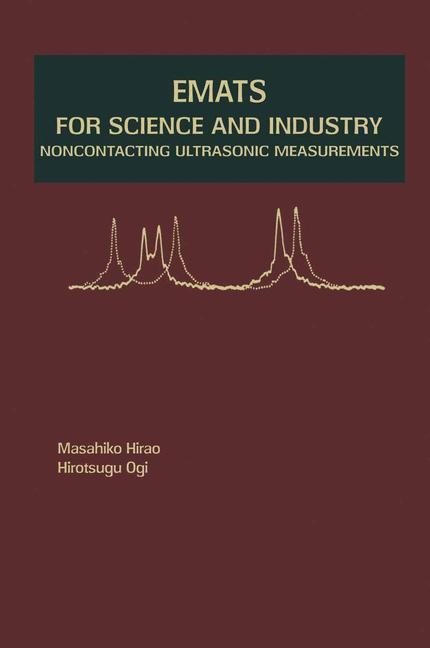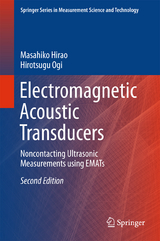
EMATs for Science and Industry
Springer-Verlag New York Inc.
978-1-4419-5366-7 (ISBN)
- Titel erscheint in neuer Auflage
- Artikel merken
Preface. Introduction: Noncontact Ultrasonic Measurements. Brief Historical Sketch of EMAT. Electromagnetic Acoustic Resonance - EMAR. Part I: Development of EMAT Techniques. 1: Coupling Mechanism. 1.1. Background. 1.2. Generation Mechanism. 1.3. Receiving Mechanisms. 1.4. Comparison with Measurements. 2 : Available EMATS. 2.1. Bulk-Wave EMATs. 2.2. Longitudinal-Guided-Wave EMAT for Wires and Pipes. 2.3. PPM EMAT. 2.4. Meander-Line Coil SH-Wave EMAT. 2.5. SH-Wave EMAT for Chirp Pulse Compression. 2.6. Axial-Shear-Wave EMAT. 2.7. SH-Wave EMAT for Resonance in Bolt Head. 2.8. Rayleigh-Wave EMAT. 2.9. Line-Focusing EMAT. 2.10. Trapped-Torsional-Mode EMAT. 2.11. EMATs for High Temperature Measurements. 3: Brief Instruction To Build EMATs. 3.1. Coil. 3.2. Magnets. 3.3. Impedance Matching. Part II: Resonance Spectroscopy with EMATs -EMAR-. 4: Principles of EMAR for Spectral Response. 4.1. Through-Thickness Resonance. 4.2. Spectroscopy with Analog Superheterodyne Processing. 4.3. Determination of Resonance Frequency and Phase Angle. 5: Free-Decay Measurement For Attenuation And Internal Friction. 5.1. Difficulty of Attenuation Measurement. 5.2. Isolation of Ultrasonic Attenuation. 5.3. Measurement of Attenuation Coefficient. 5.4. Correction for Diffraction Loss. 5.5. Comparison with Conventional Technique. Part III: Physical-Acoustics Studies. 6: In-Situ Monitoring Of Dislocation Mobility. 6.1. Dislocation-Damping Model for Low Frequencies. 6.2. Elasto-Plastic Deformation in Copper. 6.3. Point-Defect Diffusion toward Dislocations in Deformed Aluminum. 6.4. Dislocation Damping after Elastic Deformation in Al-Zn Alloy. 6.5. Recovery and Recrystallization in Aluminum. 7: Elastic Constants and Internal Friction of Advanced Materials. 7.1. Mode Control in Resonance Ultrasound Spectroscopy by EMAR. 7.2. Inverse Calculation for Cij and Qij-1. 7.3. Monocrystal Copper. 7.4. Metal-Matrix Composites (SiCf/Ti-6Al-4V). 7.5. Lotus-Type Porous Copper. 7.6. Ni-Base Superalloys. 7.7. Thin Films. 7.8. Piezoelectric Material (Langasite: La3Ga5SiO14). 8: Nonlinear Acoustics. Part IV: Industrial Applications. 9: On-Line Texture Monitoring Of Steel Sheets. 9.1. Texture of Polycrystalline Metals. 9.2. Mathematical Expressions of Texture and Velocity Anisotropy. 9.3. Relation between ODCs and r-Values. 9.4. On-Line Monitoring with Magnetostrictive-Type EMATs. 10: Acoustoelastic Stress Measurements. 10.1. Nonlinear Elasticity. 10.2. Acoustoelastic Response of Solids. 10.3. Birefringence Acoustoelasticity. 10.4. Practical Stress Measurements with EMAR. 10.5. Monitoring Bolt Axial Stress. 11: Measurements On High-Temperature Steels. 11.1. Velocity Variation at High Temperatures. 11.2. Solidification-Shell Thickness of Continuous Casting S
| Erscheint lt. Verlag | 3.12.2010 |
|---|---|
| Zusatzinfo | biography |
| Verlagsort | New York, NY |
| Sprache | englisch |
| Maße | 156 x 234 mm |
| Gewicht | 593 g |
| Themenwelt | Naturwissenschaften ► Physik / Astronomie ► Mechanik |
| Technik ► Maschinenbau | |
| ISBN-10 | 1-4419-5366-3 / 1441953663 |
| ISBN-13 | 978-1-4419-5366-7 / 9781441953667 |
| Zustand | Neuware |
| Haben Sie eine Frage zum Produkt? |
aus dem Bereich



